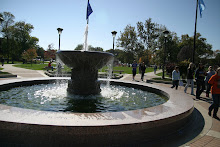by Hadeiyah Ameen
When EcoLab Director and Professor David Benson was young, he was unaware of the variety of species of birds. A college field trip in Colorado introduced Benson to a “world of interesting diversity amongst critters” as he described it.
Currently, Benson immerses himself in the world of animals, as he hosts the bird walk on Wednesdays at 8a.m. and the night prowl on Fridays at 5:30p.m. in the EcoLab.
A few weeks ago Benson enjoyed a bird walk through the Ecolab with his colleague and astrologist Randy Patrick, who also attends the night prowl and gives students intriguing facts about the stars. Benson and Patrick took the ‘Spring path’ to search for different bird species, and they found many of them, including: Wood Ducks, Great Blue Herrons, White Faced Ibis, Cardinals, Red winged-Blue Birds and many other species. Altogether, they sighted about 15 species of birds during a two-hour period.
Benson and Patrick discussed other species of birds they have seen in the Ecolab including the Asian Crain, a bird originally from Japan. They also saw the Warbler bird, which has more than 32 different species; Benson said they are considered “jewelry for the trees”. They saw the Baltimore Oriole, the rare Yellow bellied-Sap Sucker often seen in Indianapolis, and the Phoebes, a mid-air insect-eating bird. Benson, intrigued, watched a Phoebe bird fly from a tree branch, eat a flying insect and then return to its branch.
These avid bird watchers experienced a moment of slight frustration when they heard the “Nemesis bird,” a bird they could hear but could not find.
Although bird watching can be fun, it can be competitive when bird watchers race to discover the most birds. Benson and a group of his students participated in what is called a “Birdathon,” a competition where contestants have two hours to find as many species of birds as they can. The competition raises funds for bird-related studies, such as the effects of noise pollution on birdcalls. Benson’s team has won two years in a row, finding about 141 different species of birds.
During the winter, about 30 species of birds inhabit the EcoLab, while in the summer about 60 are flying about, according to Benson. With summer fast approaching, the EcoLab will be filled with a variety of birds, and Benson invites students to join him at the St. Francis Colonnade Wednesdays at 8a.m. and Fridays at 5:30p.m.
skip to main |
skip to sidebar

The Knight Times is a student newspaper dedicated to serving the Marian University student community. Our goal is to inform the Marian community on campus, local, and global issues. We strive to report the stories that matter and take student opinions and comments into consideration. We want you to read, comment, and enjoy!
Welcome to

- The Knight Times
- The Knight Times is a student newspaper dedicated to communicating campus, local, and global issues to the Marian University student community. We want you to read, comment and enjoy!
Photos Taken By:
Michael Schrader
David Leszcynski
Michael Schrader
David Leszcynski
Blog Archive
-
▼
2012
(28)
-
▼
April
(13)
- Student government elects new officers
- Marian goes global
- Cycling: a global sport
- German students meet Eva Kor, Holocaust survivor
- Anatomy of the crucifixion
- Biology students study in Puerto Rico
- Nursing students serve in Honduras
- Shoeless students stir debate
- Marian: Building Bridges, Med school
- First Show Choir initiated at Marian
- Bird watching tours in the EcoLab
- Speaking Center opens doors
- Simon Bruté Lecture 1st Annual Lecture
-
▼
April
(13)
Stay Tuned for our NEXT Issue...
February 24 2012